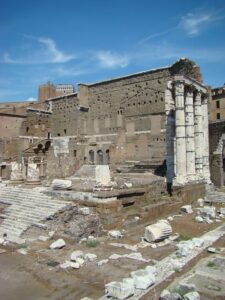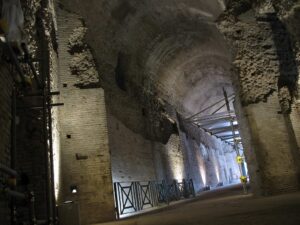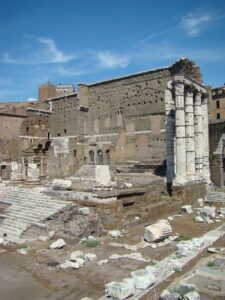Roman Architecture as Political Propaganda
Table of Contents
Exploring the Political Messages in Roman Structures
Introduction
Roman architecture functioned as a political tool throughout its history. In both Republican and Imperial Rome, structures were designed to convey specific political messages. Republican Rome emphasized civic virtue and shared governance, while Imperial Rome focused on the authority of the emperor and the divine right to rule.
Republican Rome: Architecture of Civic Virtue
In Republican Rome, the Roman Forum emerged as a central civic space, symbolizing the ideals of shared governance and civic virtue. This area was not only a marketplace but also a venue for political discourse, legal proceedings, and public gatherings. The Forum represented the collective identity of Roman citizens, emphasizing their role in governance. Structures within the Forum, such as the Senate House and various temples, were designed to reflect the values of the Republic, promoting the idea that power resided with the people rather than a singular ruler. This architectural focus on civic engagement reinforced the principles of republicanism and the importance of public service.
Temples and Military Vows
Temples built in Republican Rome often commemorated military victories. For instance, the Temple of Mars was constructed following military successes, serving as a reminder of the responsibilities of Roman generals. These structures were not merely religious sites; they were also political statements, reinforcing the connection between military success and civic virtue, thus promoting the idea that military leaders served the Republic.
Early Monuments and Triumphal Processions
Triumphal processions celebrated military achievements, emphasizing service to the state rather than personal glory. Generals paraded through the streets, showcasing their victories and the spoils of war. The architecture along the route, including triumphal arches, served as a backdrop for these events, reinforcing the connection between military success and the Republic’s ideals. This public display of power was a crucial aspect of Roman political culture, linking military success to civic pride.
Elite Homes as Public Statements
Elite homes, or domus, show the values of modesty and tradition in Republican Rome. The architecture of these residences often emphasized simplicity and functionality, aligning with the ideals of civic virtue. By choosing to build modest homes, the elite communicated their commitment to the Republic’s values. This architectural choice served as a public statement, reinforcing the notion that true virtue lay in service to the state rather than personal wealth.
Imperial Rome: Architecture of Domination and Divine Rule
In Imperial Rome, architecture shifted from civic virtue to expressions of imperial power. This shift marked a departure from the Republican ideals of modesty, as emperors used architecture to project their authority and divine right to rule. Public benefaction became a tool for emperors to legitimize their power, and monumental structures were constructed for the populace.
With the transition to Imperial Rome, architecture began to reflect the power and authority of the emperor. The Domus Aurea, built by Nero, marked a shift from public benefaction to private excess, showcasing the emperor’s wealth and divine right to rule. The residence symbolized the growing disconnect between the emperor and the populace, as architecture became a means of asserting dominance rather than promoting civic virtue. The size of imperial structures served to reinforce the idea of the emperor as a near-divine figure, further entrenching the notion of absolute power within the Roman state.
The construction of the Flavian Amphitheatre, commonly known as the Colosseum, is another example of the shift in architectural focus during the Imperial period. In contrast to the Domus Aurea, this monumental structure was built to entertain the masses and distract them from political issues, reinforcing the emperor’s control over public life. The amphitheater served as a symbol of imperial power, showing the state’s ability to provide for its citizens through grand spectacles. This architectural shift from civic engagement to entertainment reflected the changing priorities of the Roman state, where the emperor’s authority was maintained through spectacle rather than civic virtue.
Triumphal Arches and Victory Propaganda
Triumphal arches became prominent during the Imperial period, serving as visual narratives of military success and imperial authority.
The Arch of Titus, for example, depicted scenes from the Jewish War, connecting the emperor’s role as a military leader and protector of the state. The architecture of triumphal arches served to instill a sense of pride and unity among the populace, while simultaneously promoting the idea of the emperor as a central figure in Rome’s military successes.
Such arches were strategically placed to dominate public spaces, ensuring that the messages of victory and authority were inescapable for all citizens.
Forum of Augustus and Temple of Mars Ultor
The Forum of Augustus, inaugurated in 2 BC, was designed to reinforce Augustus’s dynastic legitimacy and divine connection. The Temple of Mars Ultor within the forum served as a reminder of Augustus’s military victories and his role as a protector of the state. The architectural layout and decorative elements of the forum emphasized Augustus’s lineage and his connection to Rome’s mythic past, linking him to the gods and reinforcing his authority. This architectural strategy was a deliberate attempt to solidify the emperor’s position and promote a narrative of stability and divine favor within the Roman Empire.
Symbolism in Architectural Innovation
Roman architecture employed arches, concrete, and large-scale engineering to project superiority. The use of arches allowed for the construction of larger and more stable structures, while concrete enabled the creation of monumental buildings. These innovations were not merely functional; they served as symbols of Roman power. The scale and size of Roman architecture communicated the might of the empire to both citizens and foreign observers.
Roman architecture was designed to communicate with various audiences, including citizens of Rome, provincial elites, and foreign observers. The beauty and size of public buildings and monuments served to unify the Roman populace, instilling a sense of pride and belonging. For provincial elites, these structures represented the power of Rome and the benefits of allegiance to the empire. Foreign observers were meant to be impressed by the scale and sophistication of Roman architecture, reinforcing the idea of Roman superiority.
Read more about other key aspects of the Roman Empire:
- Ancient Roman Architecture and Its Legacy
- Ancient Roman Economy: Economic Insights of Ancient Rome
- Ancient Roman Coin Abbreviations
- Indo-Roman Maritime Trade
- Roman Maritime Symbolism
- Roman Mining
- Roman Ports and Maritime Infrastructure
- Roman River Networks
- Seaborne Trade in the Roman Empire: Routes, Ships, and Seasonal Logistics
- The Evolution of Roman Currency: A Historical Overview
- The Roman Navy and Maritime Security
- Borders of the Roman Empire
- Climate of the Roman Empire
- Demography of the Roman Empire
- Honorary Titles for Cities in the Roman Empire
- Languages of the Roman Empire
- Understanding Roman Law: Structure and Influence




